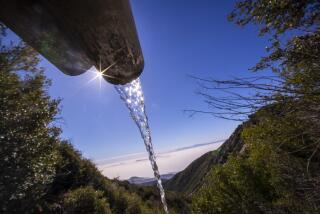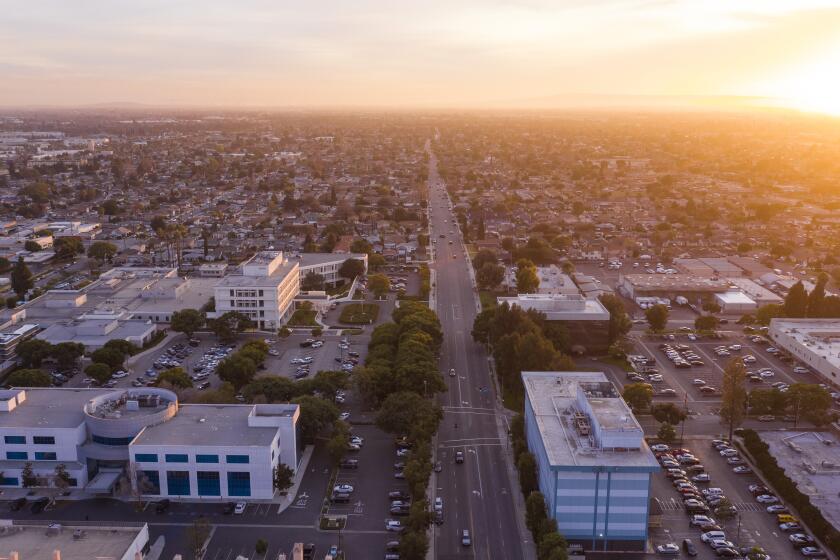Lake Must Rise Before Streams May Be Diverted : Water: Ruling is the third time in three years that judge has overruled attempts by the city to resume use of water from the Eastern Sierra basin.
- Share via
SACRAMENTO — In a decision that deprives the city of Los Angeles of an important water source, an El Dorado County court held Thursday that the protection of a unique ecosystem requires that no more water be diverted from Mono Lake to Southern California in the near future.
Ending a legal skirmish between the city and environmentalists, Superior Court Judge Terrence Finney ruled that lake levels must be allowed to rise another two feet to ensure protection of a colony of California sea gulls and other wildlife before Los Angeles can divert water for urban dwellers.
City officials, estimating that it would take years for the lake to reach the 6,377-foot level set by Finney, said Los Angeles could have gained an additional 50,000 acre-feet of water a year if the decision had been favorable. An acre-foot supplies a typical Los Angeles family of five with water for about 18 months.
“The (city) is disappointed with this ruling because the evidence presented by experts during the injunction hearing pointed to a very different conclusion,” said James F. Wickser, the Los Angeles Department of Water and Power assistant general manager. “The evidence showed that no significant impact to the lake’s ecosystem would occur if planned diversions of four streams tributary to Mono Lake were resumed.”
The ruling comes as the city is attempting to cope with the fifth year of drought and will require more purchases of expensive replacement water from the overtaxed Metropolitan Water District of Southern California.
Los Angeles’ plight, however, drew little sympathy from victorious environmentalists, who accused the city of waging a costly court battle rather than devoting time and money to find alternative water sources.
Martha Davis, executive director of the Mono Lake Committee, an environmental group, said the city should have abandoned the legal battle and sought instead to negotiate with conservationists on the future management of the lake. She said that under a new Mono Lake protection law, Los Angeles could have been eligible for $60 million to find alternative water sources if an agreement had been reached.
“The bureaucrats and attorneys at DWP have squandered millions of the city’s taxpayer dollars trying to evade their legal and moral responsibility to protect Mono Lake. From our standpoint enough is enough,” said Davis.
Her criticism was echoed by at least one Los Angeles City Council member, Zev Yaroslavsky, chairman of the Budget and Finance Committee. “I’ve advocated a non-legal settlement to that problem for years,” he said. “The wisdom of that position is even more evident now than it was last year: we keep losing. And no wonder. Society believes Mono Lake is worth saving.”
The ruling, which reaffirms a preliminary order issued in August, 1989, was the third time in three years that Finney has overruled attempts by the city to resume its diversion of water from the Eastern Sierra lake basin. Until stopped by the 1989 court action, tributaries feeding Mono Lake had been one source of water for the Los Angeles Aqueduct since 1941.
Thursday’s ruling was in response to a city request that Finney dissolve the 1989 rulings establishing minimum lake levels because the lake’s gull colony appeared to be suddenly flourishing after a period of decline. Attorneys for the city cited the resurgence of the gulls as proof that lower lake levels would not harm wildlife.
But an unimpressed Finney, in language that sometimes bordered on ridicule, scolded the city for suggesting that a one-year increase in the gull population was enough evidence to support continued draw downs of the lake.
“The court does not want to seem flip in its comments, but after hearing all the experts’ testimony concerning the California gulls at Mono Lake,” Finney wrote, “the court was as much impressed with what they did not know or could not explain as with what they did know.”
Undisputed, he said, was the fact that land bridges form as lake levels drop, giving hungry coyotes access to islands that have become nesting grounds for the gulls.
“To put it somewhat differently,” Finney said, “there is simply too much we don’t understand about the California gull and its nesting habits to allow us to roll the dice by land-bridging the islets and hoping for the best.”
Finney dismissed the city’s arguments that the loss of Mono Lake water would “adversely” affect its water supplies in time of drought by noting that Los Angeles had other water sources to which it could turn. Of greater importance, he said, was the protection of Mono Lake, which had already suffered “irreparable harm” from the city’s diversions in the years before environmentalists filed the lawsuit to try to stop them.
Finney’s order is expected to remain in effect until the State Water Resources Control Board can conduct a more exhaustive examination of the lake and issue its own order establishing lake levels. Finney can then accept or overrule that decision.
In his latest ruling, Finney suggested that after weighing the evidence the state board might conclude that lake levels should be even higher than those set by his court. He said there was certainly an “excellent chance” that the board would not set levels any lower.
More to Read
Sign up for Essential California
The most important California stories and recommendations in your inbox every morning.
You may occasionally receive promotional content from the Los Angeles Times.













